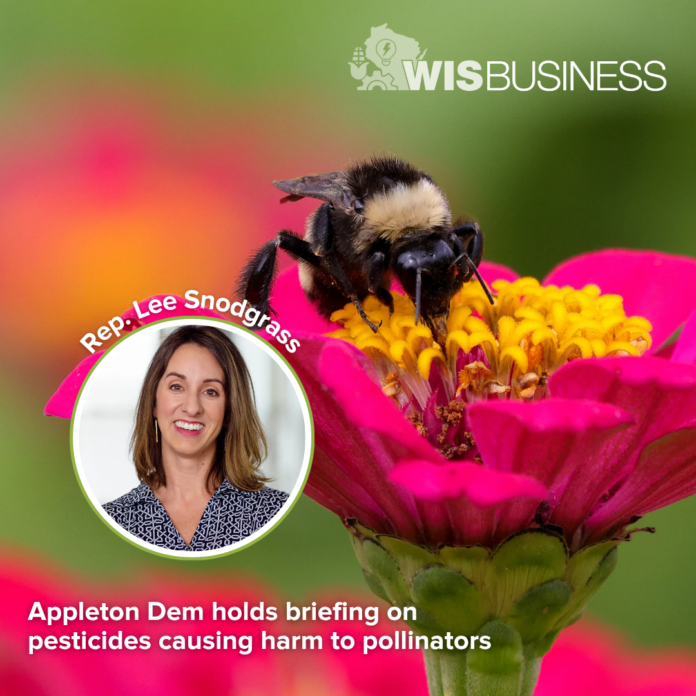Widely used agricultural pesticides nicknamed “neonics” are posing a threat to pollinators and the crops they support, experts said during a briefing at the State Capitol.
Rep. Lee Snodgrass, D-Appleton, yesterday hosted the information session with members of environmental advocacy group Clean Wisconsin and specialists from UW-Madison. She circulated a package of legislation earlier this year aimed at addressing neonicotinoid impacts, including a bill to allow local municipalities to ban certain pesticides that are harmful to pollinators.
Neonicotinoids are synthetic chemicals that were initially marketed as a safer alternative for farmers to use against insects, with low levels of toxicity for mammals. Because they dissolve in water easily but don’t bind to soil as much, the chemicals can easily move from farm fields into the surrounding environment.
Shawn Conley, a professor of agronomy and the state soybean and small grain expert at UW-Madison, estimates up to 99% of all U.S. corn and 60-70% of soybeans are treated with neonicitinoids, covering about 153 million acres in the country. They’re also used in some specialty crops, though that represents a much smaller impact.
“So that’s part of the challenge we have, is the broad and widescale use of these insecticides,” he said yesterday.
These chemicals are very effective at treating target pests such as corn rootworm, seedcorn maggot and wireworm, he explained, and “really took off” in the early 2000s as they were safer than what was previously available. But research has found neonicitinoids — or neonics for short — can have damaging effects on the ecosystems that are necessary for sustaining crop production.
Because of the chemicals’ high level of water solubility, rain can wash them off of farm fields and into the environment, exposing fish, birds and critical pollinators such as bees. When bees are exposed to low, non-lethal doses of neonics in the environment, crucial behaviors including foraging, navigation, thermoregulation, colony growth and more are all harmed.
“All the things that sort of make bees successful overall are impacted,” said AJ Jeninga, an emerging contaminants expert with the UW-Madison Division of Extension. “And these disruptions can lead to lower pollinator success, and that could impact the success of our crops, our flowers, our ecosystems in general.”
She noted one third of the global food supply depends on pollinators. That includes Wisconsin crops such as cranberries, apples, green beans, cherries and cucumbers, she said. An earlier cosponsorship memo from Snodgrass and other lawmakers noted pollinators account for more than $55 million in crop production.
Conley added as neonics have grown in use, farmers are seeing increased slug damage to their crops, as the chemicals impact ground beetles and other “beneficial” insects that help control the slug population.
Meanwhile, ongoing reviews of neonics are shedding more light on their downstream impacts. Russ Groves, a UW-Madison professor of entomology, noted the U.S. EPA routinely reevaluates registrations for pesticides every 15 years, and neonics have been up for reregistration since 2015. Most of these chemicals “have still not passed” the Endangered Species Act review, he explained, referencing three types of neonics under review.
“What it’s listing are the percentage of likely adverse effects to different species or habitats, and in almost all cases, those estimates are either at or above 70%,” he said. “So the initial biological evaluations in this review process have identified that yes, there are significant sets of species and locations, habitats, where impacts will occur.”
In a segment focused on potential human health impacts, Clean Wisconsin UW Population Health Fellow Kayla Rinderknecht noted early warning signs arose around 2010 based on animal research. These studies linked neonics with possible harm to brain growth, motor activity, memory and behavior, as well as weaker immune systems, more stillbirths and other factors.
She also referenced research on potential nervous system effects in children, showing that spraying neonics can cause headaches, dizziness, tiredness and irritation. Another study indicated that exposure before birth or during childhood can lower cognitive ability, she said.
Still, Rinderknecht said human health effects of neonics are currently very understudied.
“More research is necessary to fully understand their health impacts and to be able to set safe exposure limits,” she said.
Watch the video.






